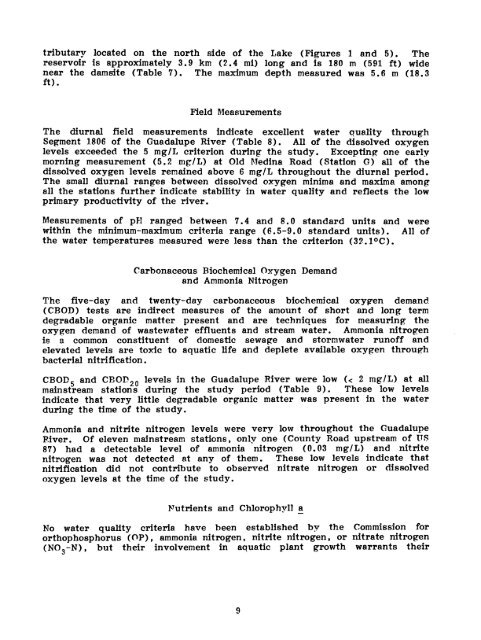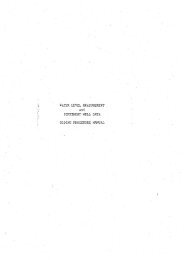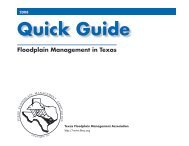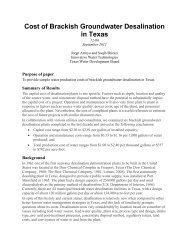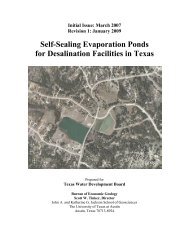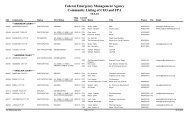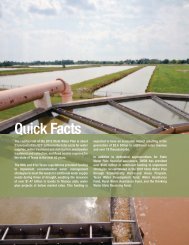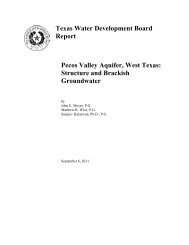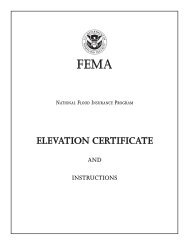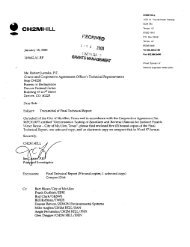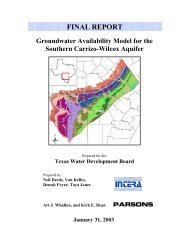Intensive Survey of the Guadalupe River Segment 1806
Intensive Survey of the Guadalupe River Segment 1806
Intensive Survey of the Guadalupe River Segment 1806
You also want an ePaper? Increase the reach of your titles
YUMPU automatically turns print PDFs into web optimized ePapers that Google loves.
tributary located on <strong>the</strong> north side <strong>of</strong> <strong>the</strong> Lake (Figures 1 and 5). The<br />
reservoir is approximately 3.9 km (2.4 mi) long and is 180 m (591 ft) wide<br />
near <strong>the</strong> damsite (Table 7). The maximum depth measured was 5.6 m (18.3<br />
ft).<br />
Field Measurements<br />
The diurnal field measurements indicate excellent water quality through<br />
<strong>Segment</strong> <strong>1806</strong> <strong>of</strong> <strong>the</strong> <strong>Guadalupe</strong> <strong>River</strong> (Table 8). All <strong>of</strong> <strong>the</strong> dissolved oxygen<br />
levels exceeded <strong>the</strong> 5 mg/L criterion during <strong>the</strong> study. Excepting one early<br />
morning measurement (5.2 mg/L) at Old Medina Road (Station G) all <strong>of</strong> <strong>the</strong><br />
dissolved oxygen levels remained above 6 mg/L throughout <strong>the</strong> diurnal period.<br />
The small diurnal ranges between dissolved oxygen minima and maxima among<br />
all <strong>the</strong> stations fur<strong>the</strong>r indicate stability in water quality and reflects <strong>the</strong> low<br />
primary productivity <strong>of</strong> <strong>the</strong> river.<br />
Measurements <strong>of</strong> pH ranged between 7.4 and 8.0 standard units and were<br />
within <strong>the</strong> minimum-maximum criteria range (6.5-9.0 standard units). All <strong>of</strong><br />
<strong>the</strong> water temperatures measured were less than <strong>the</strong> criterion (32.1°C).<br />
Carbonaceous Biochemical Oxygen Demand<br />
and Ammonia Nitrogen<br />
The five-day and twenty-day carbonaceous biochemical oxygen demand<br />
(CBOD) tests are indirect measures <strong>of</strong> <strong>the</strong> amount <strong>of</strong> short and long term<br />
degradable organic matter present and are techniques for measuring <strong>the</strong><br />
oxygen demand <strong>of</strong> wastewater effluents and stream water. Ammonia nitrogen<br />
is a common constituent <strong>of</strong> domestic sewage and stormwater run<strong>of</strong>f and<br />
elevated levels are toxic to aquatic life and deplete available oxygen through<br />
bacterial nitrification.<br />
CBOD5 and CBOD20 levels in <strong>the</strong> <strong>Guadalupe</strong> <strong>River</strong> were low (< 2 mg/L) at all<br />
mainstream stations during <strong>the</strong> study period (Table 9). These low levels<br />
indicate that very little degradable organic matter was present in <strong>the</strong> water<br />
during <strong>the</strong> time <strong>of</strong> <strong>the</strong> study.<br />
Ammonia and nitrite nitrogen levels were very low throughout <strong>the</strong> <strong>Guadalupe</strong><br />
<strong>River</strong>. Of eleven mainstream stations, only one (County Road upstream <strong>of</strong> US<br />
87) had a detectable level <strong>of</strong> ammonia nitrogen (0.03 mg/L) and nitrite<br />
nitrogen was not detected at any <strong>of</strong> <strong>the</strong>m. These low levels indicate that<br />
nitrification did not contribute to observed nitrate nitrogen or dissolved<br />
oxygen levels at <strong>the</strong> time <strong>of</strong> <strong>the</strong> study.<br />
Nutrients and Chlorophyll a<br />
No water quality criteria have been established by <strong>the</strong> Commission for<br />
orthophosphorus (OP), ammonia nitrogen, nitrite nitrogen, or nitrate nitrogen<br />
(N03-N), but <strong>the</strong>ir involvement in aquatic plant growth warrants <strong>the</strong>ir


